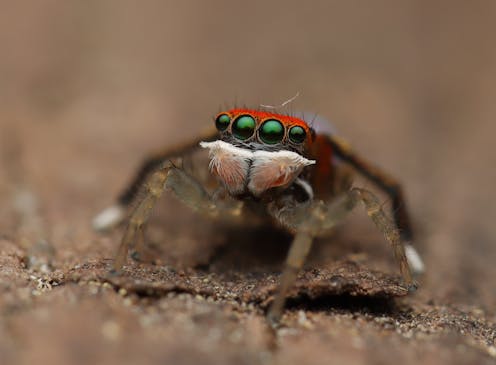Tiny splendid peacock spiders have the fastest known jump among their kin – new study
- Written by The Conversation

Jumping spiders – one of the largest spider families – get their name from the extraordinary jumps they make to hunt prey, to navigate and also to evade predators.
Male jumping spiders also jump to escape from cannibalistic females and competing males. So they are under tremendous pressure to jump efficiently and rapidly.
We studied the jumping abilities of miniature male and female Australian peacock spiders. We found that the males – incredibly light creatures, weighing just 2 milligrams – have the highest acceleration among any known jumping spider.
Our study is the first to explore and identify differences in how male and female jumping spiders undertake their impressive jumps. It’s now published in the Journal of Experimental Biology.
Unique hydraulics
Jumping is an energetically “expensive” movement strategy. To perform it, animals have to launch themselves from a surface by coordinating the movement of numerous body parts.
Some invertebrates, like ants, jump with the help of their muscles. Others, like fleas, use energy stored in internal structures that are rapidly released to trigger a leap.
Jumping spiders are different – they use a unique semi-hydraulic system. They don’t have muscles to extend their legs and power the jumps. Instead, they extend their legs by increasing the pressure of the haemolymph (fluid analogous to blood in invertebrates) in their legs, which triggers the jump.
Peacock spiders are well known for the elaborate courtship display males carry out to court females. It has captured the attention of biologists and non-scientific audiences alike. The display includes extending and waving their third pair of legs and opening the colourful flap-like extensions on the abdomen.
The quantitative description of jumping movements, known as jump kinematics, has only been conducted for four of the 6,000+ jumping spider species known worldwide. On top of this, scientists have never investigated differences in jump dynamics in male and female spiders.
Because male and female peacock spiders differ strongly in size from each other, they present a unique opportunity to identify sex-specific differences in jump kinematics.
Spiders on campus
We studied the Australian splendid peacock spider (Maratus splendens) found both on the Macquarie University campus in Sydney and in the surrounding area.
The females weighed more than twice as much as males, and the heaviest female was 6.6 times heavier than the lightest male. We scanned male and female specimens using micro-computed tomography and carried out a 3D reconstruction to determine the centre of mass of each sex.
We then filmed the jumps of male and female spiders using a high-speed camera, and tracked the animals’ centre of mass during each jump. From this, we measured a suite of kinematic measures, including jump take-off angle, acceleration, and g-force.
We found that these lighter male peacock spiders have a distinct jump choreography and kinematics compared to the heavier females.
High, fast and steep
We discovered that the splendid peacock spiders accelerated at 127.8 m/s² – more than twice as fast as the previous highest known acceleration in jumping spiders.
This rapid acceleration may have evolved to escape from predators or to track and capture fast-moving prey in their natural environments.
Though the lighter males accelerated faster, after controlling for body mass we found that acceleration in males was slower compared to females. Males and females experienced accelerations equivalent to 13.03 times and 12.5 times the force of gravity, respectively.
Interestingly, the jumps of males were at a steeper angle than those of females, which is likely an adaptation to rapidly escape from females and other males.
A question that remained was which of the four pairs of legs powered this rapid jump. To figure this out, we tracked multiple joints on all of the spiders’ legs throughout the jump.
We found that the joint on the third pair of legs had an extremely acute angle before jumping, and rapidly changed to something like a straight angle after attaining maximum acceleration. Our results show that it’s the third pair of legs that propels the splendid peacock spider into its impressive jumps.







